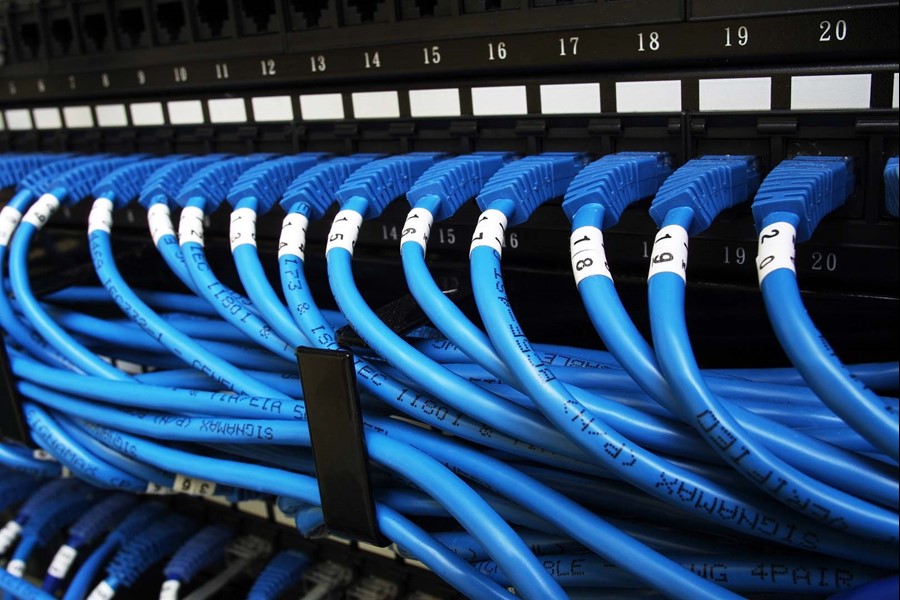Server Rack Organization: For Large and Small Businesses
The server room or at least the server cabinet is a place of duality in many companies: on the one hand, it not only houses systems that are of considerable value in themselves, but also the entire digital core of the company – and numerous internal matters as well. On the other hand, however, the server room or cabinet itself has the character of a junk room in many decidedly digital companies, the “order” of which is only accessible to a few.
Why it is important to keep the server cabinet tidy
It may not matter how tidy the place is for the basic function. And visitors to the house are also typically not taken through these “chambers”. However, chaos becomes critical whenever maintenance and repair work is due on the servers. Then, in principle, any patch cable that is not neatly laid and cannot be properly assigned can cause a real problem. Especially since it is really not difficult to create and maintain a basic order here.
Establishing responsibility in the server room
Most readers will be familiar with the saying that too many cooks spoil the broth. The same applies to corporate servers: the more employees have access to them, the more likely it is that chaos will creep in sooner or later – even if there are basic rules in place for maintaining server order.
The solution must be to appoint one person as the responsible person. This does not mean that this person is the only one allowed to work on the servers. However, he or she should monitor all work on them or at least check that it is correct.
Incidentally, it is advisable to keep the server room or cabinet locked at all times, even in small companies. Ideally, only the person responsible should have the key or password. This effectively prevents manipulation without his knowledge.
This idea is perfect if the location of the server makes it impossible for colleagues to access it unnoticed. Then it is almost impossible for them to tamper with it on their own, at least during business hours.

Avoid heat build-up through organization
Servers generate an enormous amount of waste heat. If this is not properly dissipated, the cooling systems have to work constantly at a higher power than would otherwise be necessary – which increases operating costs through higher electricity consumption. In the event of really poor planning, the constant heat can even considerably reduce the performance and lifespan of the components.
The basic key to more order in the servers is therefore to set them up in such a way that air can circulate perfectly. Usually, ventilation is from front to back. It is therefore essential to comply with the manufacturers' specifications regarding free space – sufficient space must be left in front of and behind the server.
Furthermore, entire server rooms should be cleaned regularly. Specialist companies are the first choice for this, but it is essential to check them carefully – there are many providers, but not all of them are worth the money.
Managing patch cables and other cables correctly
One of the main signs of a disorganized server is the condition of the necessary cabling. Where there is chaos, there is almost always a real tangle of cables full of loops.
All of this may work in the end. But as soon as something needs to be replaced, such a mess quickly causes confusion. The risk of pulling the wrong plug or plugging a cable into the wrong connection increases enormously – in addition to the increased time required to do everything.
But it's actually quite simple:
- Every cable has a minimum permissible bending radius. For patch cables, this is roughly ten times the cable diameter. All the cables required should be selected so that this bending radius can be maintained – but not much more, if possible.
- The entire installation should be designed in such a way that the cable run can ideally be completely horizontal and vertical; diagonal runs should only be used in exceptional cases. Strict adherence to a structured, hierarchical cabling system is enormously helpful here.
- Wherever possible and practical, cable groups should be connected to each other and, if necessary, to guide rails using cable ties and similar techniques.
If the basic requirements for servers are met and the entire cabling is carried out in accordance with EN 50173 or EN 50174, there is no reason for chaos to arise.

Effective labeling, marking and color coding
Anyone who writes a lot on the computer knows which letter is on which key without looking. Nevertheless, even professional keyboards are of course fully labeled. Why? Because it is simply easier to get clarity by taking a quick look, especially in stressful situations, rather than acting at random and possibly making a mistake.
This maxim applies even more so in a system as complex as a server. Even if only one person has access to it, who has built and connected everything themselves, maximum transparency should be the method of choice – and used abundantly.
The most important tool for this is a label printer. This is because it enables extremely diverse, low-threshold and standardized use. Handwriting can be illegible or smudged. A label printed clearly and legibly with printed letters, on the other hand, is a statement that prevents errors and chaos from the outset – if it is used correctly:
- It is essential to use a stringent system. This means using sequences, designations and abbreviations that are always the same and are based on known standards.
- Even things that are actually self-explanatory (such as “patch panel”) should be labeled as such.
- Each cable used should also have a label at both ends, with the same labeling as the corresponding connection.
In the case of entire server rooms, it is also highly advisable to use the different colors of network cables to create redundancy. This makes it possible to quickly identify what belongs to what, even in complex systems – especially if the connections are also color-coded in the same way.
At first glance, this may seem to be the opposite of orderliness, unlike racks with single-color cabling. However, the former is only seemingly clear, while a clean color coding is actually clear.
It can take a lot of effort to establish such a labeling system. However, once it is in place, it is much easier to maintain order.
Incidentally, it is then a good idea to create a large poster showing all the designations and color codes. This is extremely helpful, not least when outsiders have to work on the servers.
Sources for the images:
stock.adobe.com © Alexey | stock.adobe.com © Svitlana | stock.adobe.com © Woody Alec


